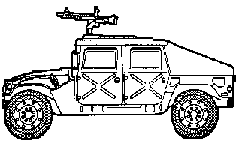 While the HMMWV is a useful system for moving loads across country, it is far too large to be used as a jeep.
While the HMMWV is a useful system for moving loads across country, it is far too large to be used as a jeep. Updated 23-8-23
Light vehicles such as those described in this article can be a very useful component of a military force. Like any military system, however, they must be used correctly. Such vehicles have only a limited level of protection against threats such as RPGs and mines.
Therefore they can only be used in environments where such threats are unlikely or in open country where there is little concealment for RPG-armed forces and the vehicle can travel away from roads and predictable routes that are likely to be mined.
The majority of auxiliary vehicle roles can probably be met by a family of vehicles predominantly based around two configurations. One form would be a pickup/flatbed/shelter-carrier. The other would be a hardtop van/ambulance. Two chassis widths would be created. The “standard” width vehicles would be more suited to urban operations. The wider variant would be used for wide loads and other situations where their width is useful. Designs would be modular, allowing for the easy installation of extra side-doors, roof-extensions, tailgates, ramps etc.
As well as fighting vehicles, a military force also needs various other types of vehicles. Military requirements for trucks have already been covered in the article here. This article discusses two smaller but equally useful vehicle types.
Vehicles suitable for military use must be designed with the realities of military service in mind. These include:
When one looks at the varieties of auxiliary vehicle currently available I cannot help but think that some seem to be undergoing something of an identity crisis. There are cars that should be trucks, trucks that try to be cars, and trucks that try to be armoured fighting vehicles.
 While the HMMWV is a useful system for moving loads across country, it is far too large to be used as a jeep.
While the HMMWV is a useful system for moving loads across country, it is far too large to be used as a jeep.
The Armament Carriers and TOW carriers (right) seem a particularly poor design. Like a reverse TARDIS, they are big on the outside but with limited capacity inside. They can only carry four to five men and lack a rear window so no-one except the gunner can see threats behind the vehicle.
If we ignore large trucks and specialist vehicles. we probably need three classes of light/medium utility vehicles. For convenience we will mimic British Army convention and call these the light, the medium and the medium (heavy duty).

When I visited EPCOT in Florida, I was very impressed with the GM exhibit and many of the “concept vehicles” illustrated there.
One type was a car called the “Chameleon”, so called because the body panels could be easily replaced to change the vehicle’s colour. The panels could also be stripped off to create a beach buggy.
More practically, this feature could be used to change the vehicle from a saloon to a convertible to a pickup.
The designer seems to have been something of an outdoorsman. The seats could be removed to be used as deckchairs and you could also detach the radio to take it to the beach with you. More usefully, a shelter could be built out of the body panels and heated with the removable heater from the dashboard.
The Africar was also based on “an extruded frame, bent in a CNC tube-bender like spaghetti, with the suspension hung off it”. Body panels of various materials could have been attached to this. Famously the prototypes used marine-plywood but the designer favoured sand-blasted stainless-steel for the production vehicles.
Despite the claims of some, the HMMWV is not a replacement for the jeep. There is still a need for a small general purpose/liaison vehicle.
The M151 is nearing the end of its service life, and interim replacements like the Wolf do not meet all the above criteria.
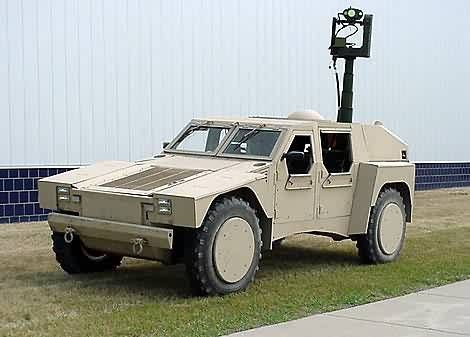 |
| “Shadow” RST-V at Army-Technology site |
When I first wrote this article, I thought a promising candidate for the light utility vehicle might be something like the RST-V. This is a jeep-sized vehicle with hybrid diesel/electric propulsion and is described as being protected against ballistic and AP mine threats.
The potential to defend against mine warfare is usually underestimated in the northern hemisphere. The Rhodesians and South Africans have managed to protect vehicles at least as small as Land Rovers against anti-tank mines. (The first version of this page was written long before operations in Iraq and Afghanistan, and sadly the previous statement proved to be an accurate prediction of things to come)
The most commonly illustrated RST-V is a four-door fully-enclosed recon vehicle with a sensor mast. However, if you look at the bottom of page 5 of this document we see a “baseline RST-V” that appears to be an open-topped four-man vehicle. It would be simple to configure this as a four-man/two-man and cargo vehicle by use of folding back-seats. I have several suggestions for such a vehicle, which to avoid confusion with the recon-model we’ll call the “General Purpose Light Vehicle”, or GPLV.
The RST-V has a sloped hood, but a support frame of tube could be added as standard without effecting the aerodynamics. This frame could also be used to attach camouflage.
There may be a need for desert or base vehicles that economize on equipment such as hydrojets and bilge pumps, but a variant of the basic field vehicle that is fully amphibious should be available. Having a chassis shaped for water operation will probably increase mine-resistance.
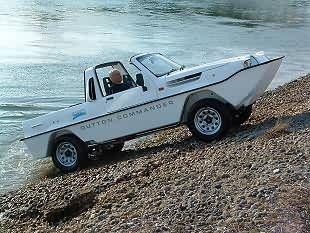

The Light Utility Vehicle or General Light Utility Vehicle (GLUV) would effectively be a run-about or used for such duties as low-risk patrolling. It would also have many applications as a civilian vehicle.
Probably the best configuration for this vehicle is something along the lines of a modernized M151 or M38 jeep.
The basic jeep was somewhat lacking in both space and capacity to carry cargo. If four men were carried there was little room inside for additional equipment. If a 106mm recoilless rifle was carried the vehicle was too overloaded for most cross-country operations.
The basic model would have the engine in the front, seating for a driver and passenger, a bench for two or three additional passengers and a small general purpose cargo area to the rear. The cargo area has a drop-gate for easy loading. The rear bench can easily be removed if more cargo area is needed. The co-driver's seat can easily be removed for odd-shaped loads. Co-driver seat and rear bench can be folded up to create more space. The rear bench can be mounted facing backwards if desired. Two rear bench units can be fitted lengthwise down the cargo space if additional seating is needed.
A roll-bar cage would be a standard fitting and would aid in mounting hard-top, soft-top and sun canopy units.
Vehicle doors can be easily fitted or removed as needed.
Modular design allows the basic vehicle to be easily adapted for operation in desert or very cold environments, or adaption for rail, wading or amphibious operation.
As well as being a general run-about and patrol vehicle, one of the potential roles of the GLUV is that it should be designed for easy air-portability. In the past few decades the military has flirted with the idea of light, highly mobile vehicles.
Many of these have been militarized dune buggies known variously by aggressive sounding names such as Fast Attack Vehicles (FAV), Light Strike Vehicles (LSV) and so on.
It is worth remembering that despite these labels the primary role of these vehicles is transportation. Even with heavy weapons fitted, these vehicles are vulnerable to nearly every type of infantry weapon.
While such vehicles have seen some use they are not without their shortcomings. Many can only hold two or three crew. While the vehicles have a good gross weight to payload ratio, the actual load they can carry and the space to stow it in is very limited. To address these problems several manufactures have offered vehicles of a more conventional configuration. In other words, engine in front, two crew behind and a general purpose cargo area.
There are obvious advantages if the GLUV runabout could also serve as a Light Strike Vehicle if there is a need for one.
Current Light Strike Vehicle designs are offered for several roles and most of these reflect the easy air-portability of such vehicles.
Traditional paratroopers are limited to marching speed once they have landed. The Air-Mech Strike concept stresses that M113s are air-droppable, allowing paratroopers to be both more mobile and armour-protected.
An alternate idea known as “Rip and Roll” suggests sometimes parachute-inserted forces might have a use for less well-protected but faster transportation in the shape of LSVs.
The USMC have a requirement for an “Internally Transportable Vehicle” that can be carried internally in helicopters. In the past they have used M151s and Mercedes-Benz IFAV. Since the USMC persists in trying to use the flawed V-22, they want future ITVs to be even smaller. Currently they are using customized M151s that they are paying at least $209,000 each for. The GLUV could be designed to meet this need, but it may be necessary to include features such as a folding roll-cage, mirrors and removable wings.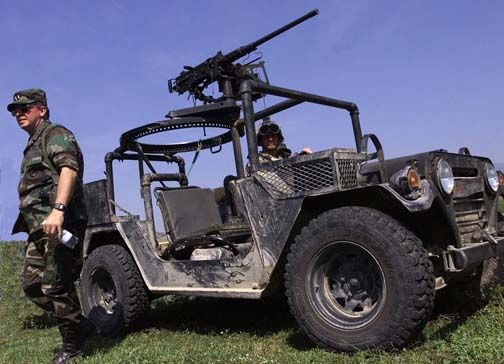
One of the more interesting applications of light air-portable vehicles is to provide transport for ground personnel involved in Combat Search And Rescue (CSAR) or Tactical Recovery of Aircraft Personnel (TRAP) missions. Vehicles offered for this role have more emphasis on passenger transport rather than armament and it would be useful if provision to carry at least a pair of stretchers was included.
It seems prudent that a future light utility vehicle design can also serve as an air-portable light vehicle in the “Rip and Roll”, ITV and CSAR/TRAP roles.
It is worth emphasizing here that such vehicles are not fighting vehicles. Any armament fitted is for self-defence or transportation.
The roll-cage of the GLUV should include provision to fit a ring-mounted machine gun or automatic grenade launcher. With an unarmoured light vehicle, discretion is the better part of valour so where practical there should be provision to fire at targets while retreating. Likewise “drive by” is a better tactic than “drive at”. The GLUV therefore needs provision to mount weapons with a 360° field of fire. Because of their backblast, weapons such as recoilless rifles and ATGWs generally can only be fired at targets ahead of or abeam of an open vehicle such as the GLUV. The roll-cage should also include provision to fit a pintle-mount for such weapons. Such a mount would allow the weapon to be easily dismounted for ground firing. Firing from a concealed or fortified position on the ground will often be safer than firing from the vulnerable light vehicle.
The “Truck, Utility, Medium (TUM)” was the British Army’s designation for the 110" wheelbase Land Rover. The Land Rovers are probably the most successful medium-size military utility design of all time. Land Rovers are used by the militaries of many nations and used for a wide range of roles. Many of the roles HMMWVs are currently used for would be more effectively performed by Land Rovers. If we are considering what form a future medium utility vehicle will take it is worth having a good look at the Land Rover.
Land Rovers come in a wide variety of styles, but the majority of military Land Rovers seem to be either of flatbed or hardtop configurations. The flatbed has seating for one or two passengers beside the driver, and a cargo area to the rear. At least six passengers can sit in benches over the wheel arches, and hoops can be fitted to allow a canopy to protect the passengers or load. Hardtop Land Rovers tend to have a door each side to access the driving compartment and one or two doors at the back of the vehicle to access the cargo area. While there are five-door and double-cabin variants, all Land Rovers are of a station wagon or pickup configuration so retain a useful cargo capacity. Many of the proposed “HMMWV replacement” vehicles I see seem to adopt a “car” configuration. A lesson we can learn from the military Land Rover is that medium and larger vehicles need to be able to carry useful cargoes.
Various armoured vehicles based on the Land Rover have been created and these have proved themselves time and time again in internal security roles, where other armoured vehicles would be too large or politically undesirable. Vehicles such as the Shortland S-55 resemble a hard top Land Rover but with slightly more head room in the rear section and provision to fit a turret and firing ports. Being a van-type vehicle rather than a car soldiers or police can rapidly exit the vehicle and it is easy to load prisoners or non-combatants.
This article on why the SAS CRW teams chose Range Rovers nicely sums up why medium vehicles like the Range Rover and Land Rover can be useful.
“In most anticipated scenarios the CRW assault teams would need to travel quickly by road to near the scene of an incident, and once there possibly traverse rough or difficult terrain.
So the, then new, Range Rover with its powerful V8 engine was simply the only vehicle for the job. As a bonus, because it had a traditional ladder chassis like the Land Rover, it could also be easily lashed down for transportation inside the C-130 Hercules and flown anywhere in the world.”
In his article here Carlton Meyer points out that many military tasks are better served by less sophisticated vehicles than the HMMWV and suggests a CUCV-type vehicle based on the Toyota.
“Rugged trucks like the Hummer are valuable in rough terrain or when heavier cargo must be moved. However, if the US Army did a study, it would find that most Hummers are employed in roles like base, camp, and airfield support, and to transport officers and maintenance soldiers around.”
Feedback on Carlton's article included:
“Start with a base model. As stripped-out-work-truck as you can obtain it as. Even if it is special order. This means crank windows, manual door locks, bench seats, and a hose-out interior. Get Hi-Lo 4wd, automatic trans, everything possible heavy duty, and off-road options, such as limited-slip and low (numerically high) gear ratios. 4wd must be engaged with a lever, and hubs must not rely on electricity or vacuum to lock, IE they must be twist to lock, cable-pull-lock or full-time locked. AC is only allowed if they put it on a separate drive belt, instead of being part of the serpentine. That way when the compressor locks up it only snaps one belt, and it's a hot ride home instead of a long hot walk home. Color should be some kind of olive green or brown or other low-observable color, but do not make it look overly 'military.' Tan might be acceptable, or even white (which becomes dirt-road camo after operating in dusty areas.
Mount a stout yet compact front bumper and push-bar unit, and make it compatible with a winch. Not all will be equipped, but make the bumper the same. Try to make it not affect approach angle too badly. Consider a pre-screen for the radiator that can be removed and cleaned quickly to restore airflow to radiator. Consider if not a snorkel at least a high air intake not prone to flooding when fording water. Also put all vents (axle, PCV, etc) high on vehicle.
Consider a ballistically protective set of glass if not cost prohibitive. Do not alter appearance of truck. Also make sure mirrors are adequate and fold rather than fall off when struck.
Put mounts in cab for equipment. Install switches for dim-lights and other features. Consider a sun-roof design. Place it so it can be used as a top hatch to observe/fire from.
Mount good tires and wheels. Consider beadlocks and a CTIS system if not cost prohibitive. Any protective guards for driveline, if not expensive, would be nice. If stock pieces inadequate replace springs, shocks, bushings, stabilizers, and other such pieces with commercial off-road equipment, but do not modify mounts so that stock equipment could not be used for spares (IE you're in East Elbonia and need a shock, don't make it so you have to wait to install a Rancho RS9000 shipped from the US when he's got piles of stock Toyota shocks.) Make these aftermarket parts available as spares. Do what is possible to protect fuel tank, see about an auxiliary.
Make the bed from composite or spray in a Rhino-liner on pickup bed models. Come up with a way to securely mount light crew-served gear in there. Also come up with a seat and canopy system. Mount a stout rear bumper with a military standard hitch and hook-up.”
As well as the Toyotas, another family of vehicles worth a look are the Land Rovers. These are already to military specification and are widely used throughout the world, being in service with the armed forces of over 140 countries and also not uncommon in civilian ownership. Current models such as the Discovery-series lack the distinctive “Land Rover nose” of older models and at a distance resemble other vehicles such as Toyotas, so can blend-in as Carlton suggests. Spares and maintenance expertise will not be in short supply in most parts of the world. Currently Rover is in financial difficulty but Land Rovers are also manufactured or assembled in several other countries and there is a good case to be made that compatibility with Land Rovers should be a feature of future military vehicles.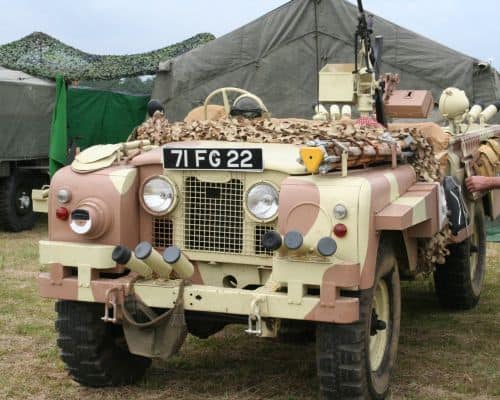
The brown and sand camouflage scheme on the left works in a variety of environments, not just desert. If the object is identified as a vehicle it resembles the rust and dirt often common on third-world vehicles, causing an enemy to possibly hesitate thinking it is a friendly or civilian vehicle. This camouflage therefore employs elements of mimesis as well as crypsis.
The HMMWV is an iconic American vehicle. Insurgents who see a HMMWV know that it probably contains Americans. What is needed sometimes is something that is generic that will blend in and not be immediately obvious as hostile.
The whole idea of a “pure HMMWV” scout unit needs to be questioned. This article points out the HMMWV platoon’s many limitations for forward reconnaissance in support of a task force.
If you are a long way behind enemy lines on deep reconnaissance you need to be driving something that at first glance looks like a friendly or civilian vehicle, therefore generic looking vehicles that look like Land Rovers, Unimogs and GAZ make the most sense. The ideal special forces vehicle would look like a typical cargo-carrying truck. Inside it would have the communication and navigation systems needed to direct air attacks. Defensive armament would be concealed until needed.
For reconnaissance nearer the front line, guerrilla-hunting, etc then light vehicles like the Land Rover/Toyota concept do have a place, but they need to be part of a formation with other vehicles that have better protection and firepower. A formation would be something like a unit of sensor and dismount-carrying M113s supported by M113-based 76mm GT4 armed Tankitas/light tanks, with Land Rover/Toyotas and bikes or quads acting as point and flank. Vehicles may need to be modified with façades so they mimic civilian or friendly vehicles as Carlton suggests. The point vehicle may lack a roof-mounted weapon or have it concealed. Vehicles such as the ALTV series offer basic protection and can probably be made to pass as Toyotas.
A Land Rover Defender has a width of 70" which contrasts with the HMMWV’s 86". This means that it is easier to transport a Land Rover by helicopter, transport aircraft or ship and easier to navigate narrow streets.
“The rangers chose the Land Rover SOV because it has a greater capacity than DPV/LSV buggies but, unlike the HMMWV, is small enough to be readily transported by helicopter (2 fully equipped SOVs fit in the hold of a Chinook helicopter), something vital for air-deployable forces such as the rangers. The SOV can carry up to 7 rangers.”
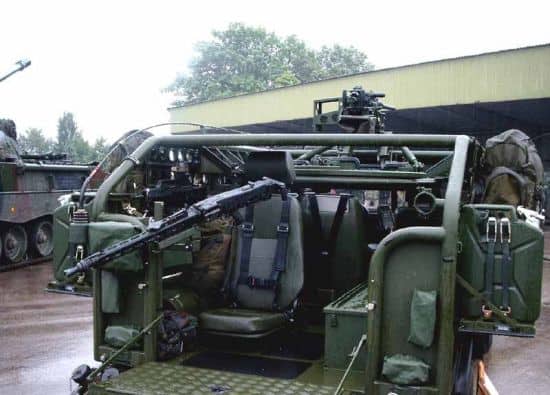 The Ranger SOV has the right idea, but the seats in the rear should be facing to the rear. This would offer numerous advantages including better situational awareness and more effective use of the cargo area. A rear-firing machine gun mount should be fitted as standard in addition to the central weapon position.
The Ranger SOV has the right idea, but the seats in the rear should be facing to the rear. This would offer numerous advantages including better situational awareness and more effective use of the cargo area. A rear-firing machine gun mount should be fitted as standard in addition to the central weapon position.
This Austrailian Airfield Defence Quick Reaction vehicle has the right idea with rear facing rear seats but the vehicle needs the side cutouts for quick disembark.
A future medium utility vehicle must pay heed to the lessons learnt in decades of Land Rover use, while improving on areas where deficiencies have been apparent, such as mine-protection. The British Army’s purchase of the Navistar MXT-MVA as the Husky Protected Support Vehicle seems a step in the right direction.
Useful though the GLUV and medium utility vehicle will be, it cannot totally replace the HMMWV. Most versions of the HMMWV have a much greater capacity than the M1025A2 model used for comparison with the RST-V.
It would be useful to have an auxiliary vehicle that can handle cargoes that are heavier or bulkier than can be easily moved in a Land Rover-style medium vehicle. In British service such a role was taken by the One Tonne 101 Land Rover, which has been replaced by the Pinzgauer 716M or “TRUCK UTILITY MEDIUM (HEAVY DUTY) (TUM(HD))”. This is the sort of job the HMMWV should be used for.
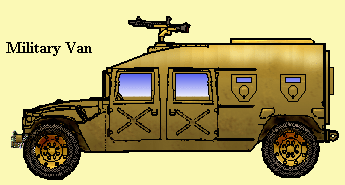 |
 |
Specifications for a HMMWV replacement are already being drawn up. Although supposedly reaching the end of their service life, HMMWVs are likely to be around for some time, so it makes sense for the new vehicle to share common components where possible.
I’ve heard that current HMMWVs cannot operate in certain European towns, although whether this is due to their width or their turning circle I don’t know. Certainly the HMMWV cannot fit in helicopters such as the CH-47. On the other hand, many African roads are basically two trenches with a mound between and a problem for any vehicle with a narrower wheelbase and less ground clearance than a truck. Proposed for the RST-V is a variable suspension system which can be widened or narrowed so the vehicle can fit in the cramped interior of the flawed V-22 aircraft. V-22 cargo space is about 68 inches wide, 66 inches high and 250 inches long. Such a width-reducing system in larger vehicles would allow them to be moved by C-47, operate in narrow streets or alleys and still be negotiate poor African roads. Being able to move the wheels further from the crew compartment will also provide added mine-protection.
For this vehicle class I’d create something that would basically be a cross between a HMMWV and a transit van (aka “panel truck”). I call this the “Hybrid Electric Van-Armoured”, or HEV-A
This one basic “five-door” configuration should be adaptable to most duties. Those tasks for which a van configuration are not suitable can probably be performed by a two-door flatbed version that would also serve as a shelter-carrier.
An interim military van could be created as a variant of HMMWV that could replace most existing variants. The above illustration does not attempt to depict features such as amphibious capability. An amphibious version would probably look more like the Russian GAZ-3937 Vodnik (below)
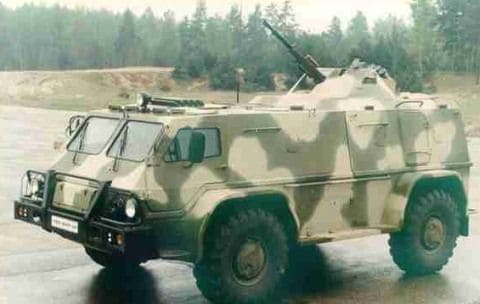 | GAZ-3937 GAZ-3937 Vodnik Vodnik Video Vodnik at Omsk-99 Vodnik at Jedsite Vodnik at Global Security |
This vehicle would be a wheeled light-armoured transport and tractor. I’m avoiding terms like APC and “tactical” since this would imply a combat role and the events described in “Black Hawk Down” by Mark Bowden clearly illustrate that HMMWVs are not a substitute for real armoured personnel carriers. The armour and weapons of the vehicles described on this page are intended to be defensive.
Ref.“You could make vehicles like an ARMtruck or Military Van from aluminum, but aluminum burns. (actually, it doesn’t under field conditions!) I think today there are alternate materials that would now be practical, such as ceramics or cast steel. Set up the production line right and you could turn them out by the thousand. They’d even be cheap enough to use in civilian trucks too.
It amazes me that military vehicles don’t have attachment points for basic engineering gear fitted as standard. Most vehicles have winches, so a couple of poles to form an A-frame would often eliminate the need to wait for a recovery vehicle. Pretty useful if a vehicle in your convoy has hit a mine or just run off the road.
Being able to fit a dozer or snow plough blade to any vehicle would make sense too. If you are going to attack a convoy trying to block the road is an obvious tactic, plus there’s snow or drifting sand dunes.”
Mike Sparks, 1st Tactical Studies Group, writes:
Phil, a 2nd ACR with HEV-As with gunshield on the main ring-mount could easily fly 2 at a time in a C-130 with 9-man dismount scouts....and fly by both UH-60L and CH-47 helicopters....unlike a 20-24 ton LAV-III/IAV 8x8 armored car...
I suggest you change your SUPERB drawing to show a gunshield...
PW: As you mention on your page, such vehicles certainly should have gunshields. Also such a shield should offer all round protection like the ACAV turret, since ambushes are not usually from the front only. I was torn between adding an ACAV type turret (as it would probably have) and making it look like an APC, or leaving the MG as-is was to stress that the vehicle was armed and capable of self protection, but not an assault vehicle.
The true HEV-A would look very different: I didn’t draw in any of the amphibious features either. This illustration is closer to what the HMMWV based military van would look like. You could build these now, then let it evolve by adding the hybrid drive later, then work on the new amphibious body and variable width suspension. An evolutionary, not revolutionary approach, and one which means the troops don’t have to wait years for something useful and better.
Correction:
Two HMMWVs CAN RO/RO inside a CH-47D Chinook helicopter we did this in Desert Storm to get better flight speeds/ranges; Army Aviators are just lazy and don’t want to remove troop seats and take time in an open danger area unstrapping HMMWVs free---the problem is our primitive restraint system. So we sling-load.
Ed Sackett adds.
In England, jeeps were known as pneumonia wagons, and various cloth and plywood cabs appeared almost instantly. Let me suggest a one-piece (if possible) molded clear plastic cab that snaps off for combat runs.
The section on Schwimmwagen and Light Recon vehicles has been moved to this page
By the Author of the Scrapboard : | |
|---|---|
 | Attack, Avoid, Survive: Essential Principles of Self Defence Available in Handy A5 and US Trade Formats. |
 | |
 | Crash Combat Fourth Edition Epub edition Fourth Edition. |
 | |
 | |